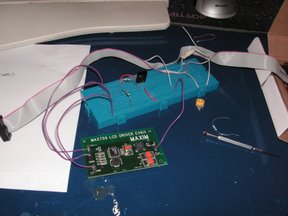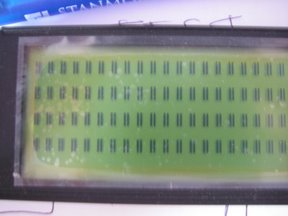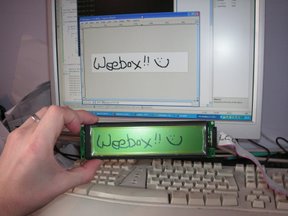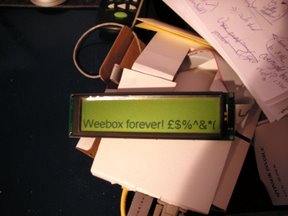It's Alive! (again!)
Well, it’s been a while since I’ve had time to work on the Weebox — and part of that’s due to the lack of a working LCD screen (covered amply in A frustrating evening). Yesterday morning this all changed with the arrival of the new, working, negative voltage generator.
I’ve bought an LCD negative voltage generator evaluation board from Maxim IC. Rather than try and solder on all the tiny and hard-to-find components needed, I plumped for the cheating method of getting Maxim to do it for me. All I had to do was solder on the +5V, GND, Shutdown and Output wires — which even with my hamfisted soldering skills wasn’t too hard:
With the new board in place, I excitedly connected everything up, carefully ensuring the shutdown pin was low until initialisation had finished…then I ran my test program…
Looks like it’s working....kinda…but what’s with all the gaps? A quick look through the code and in my frustration the other night at it not working I’d introduced so many bugs it wasn’t even slightly working. A bit of fixing…and then a bit of fiddling in the GIMP, and I suddenly had this:
Hallelujah! After many months of bug-hunting, breaking things with too much solder heat, blowing up components, ordering the wrong things, paying import duty, swearing and cursing I finally had a working, graphical, 320 x 64 LCD screen.
I was over the moon! I then spent the rest of the day making up a bit of breadboard with the components on instead of the mess of wires in the prototype board. Although in doing so I overheated the IR detector and fried that — oops it was all going a bit too well, another one’s in the post though. Once it was all settled in I turned to software matters again.
The LCD driver I was writing was in C++, but the Weebox stuff is in Python. I was tempted to rewrite the lot in C++, but the flexibility of Python is too hard to resist. A chat with a friend who suggested an RSS news ticker confirmed this: It would be a few lines of Python but reams of C++. However, I couldn’t implement the LCD driver in Python, it’s just not fast enough. So I had to bridge the two languages with SWIG — which turned out to be almost totally painless. After a few blind alleys I had a python-callable module that could initialise and clear the display and draw pixels, lines and filled rectangles.
By this time the poor 200MHz ARM wasn’t cutting it for compiling, the C++ code was taking minutes to build. An hour invested in getting SCons and the Arm cross compilation setup working on my PC was very well invested — the turnaround time now is seconds. I have the Weebox’s NFS root mapped as a Samba drive, so I directly edit and compile the code onto the Weebox’s disk in Visual Studio. Much faster, just F7 and an alt-tab to the Putty shell on the weebox is all it takes. Marvellous. With a bit of tweaking I could set the ‘debug executable’ on VS to be an rexec of the weebox, but that’s enough for now.
Latterly I started thinking about fonts. I was originally going to draw my own just like I always did on the Spectrum and Beeb all those years ago. However, I had a thought: 320x64 is enough for pretty decent-sized letters…why not use TrueType fonts? Within a few minutes I’d read the FreeType tutorials and I was ready to go. After a few false starts and a strange 1bpp bug (if you render a space in 1bpp mode FreeType seems to do a divide by zero on ARM), I had this:
As it’s just gone 11pm and I’ve not stopped since about 10am, I think I’m going to stop here. I need a good long think about how it’s all going to fit together, and how I’m going to optimise the TrueType rasteriser (which currently runs with uncached glyphs and plotting each pixel individually! yuck!) But it’s looking very promising. If only I hadn’t blown the bloody infra-red detector up, I’d have ‘final hardware’ at last. Oh well, should arrive on Tuesday, and then I’ll have a completed Weebox, just lacking in software.
Update: next day the new IR detector came…and in installing it I noticed that I’d put +5V and GND the wrong way round on my circuit plan…oops…I probably hadn’t toasted it after all. Anyway, I now have a ‘working’ final hardware Weebox, playing music, displaying stuff onscreen in pretty fonts and receiving commands from the IR display. Sadly I reckon Python’s not going to cut it after all, running just the screen screen at the moment is taking 30% CPU with nothing else going on, and that’s not enough to get OGG playback without clicks every now and then. Oh well!



